Provisioning - Starting a Provisioning Notebook to Track Your Use of Supplies
By Sheryl Shard, copyright 2015. All rights reserved.
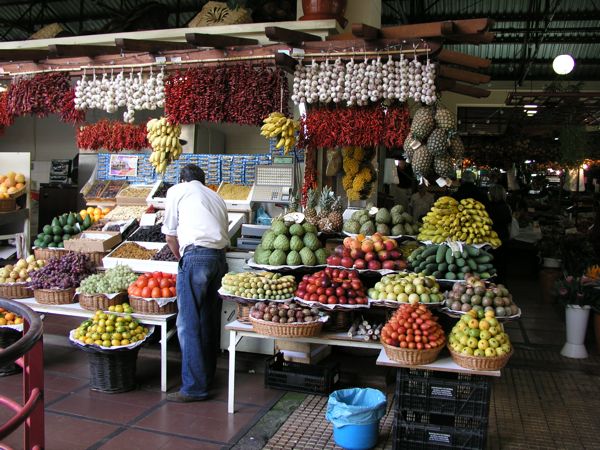
The delights of shopping in foreign markets.
The colourful market in the Portuguese island of Madeira.
Several months before our first major cruise in 1989, Paul and I started tracking our food and supply usage at home. This was the first step in designing a custom provisions list based on our individual needs and preferences.
We used a small three-ring binder with alphabetical index tabs which now contains complete and thorough lists of all our regular supplies. We entered items alphabetically in our binder every time we went grocery shopping and as we used things around the house and boat.
Over time, we developed a custom inventory of food items, cleaning and maintenance products, household goods and first aid supplies. We made notes beside each entry on how quickly we used things up, in what seasons we tended to eat more of certain foods and the changes in consumption rates of various products when guests stayed for a while.
This book is still our bible for provisioning. We consult it every time we go shopping to remind us of things we need. It is the foundation for our cruising inventory and provides reliable guidelines for how long we can cruise in isolation based on the supplies we have on board at the time.
Of course, when living aboard the boat, your regular eating habits and supply usage change somewhat due to factors such as the availability of certain products, your increased appetites due to physical activity and the galley equipment aboard your boat. However, we have found that our favourite foods at home are still the foundation of our provisions list for the boat.
As we travel, we discover new foods when we explore local markets and sample exotic cuisine in the ports we visit. In Spain, we developed a fondness for custard apples; in the Azores, two local women showed us how to prepare a delicious octopus stew; and in Brazil, a village boy introduced us to a refreshing bottled drink made from the fruit of the cashew tree. We make notes in our binder of any new “finds” and take them into consideration for future provisioning. I'm sure there is an app for this somewhere but my good old fashioned binder notebook that fits easily in my purse or backpack has served me well for years.
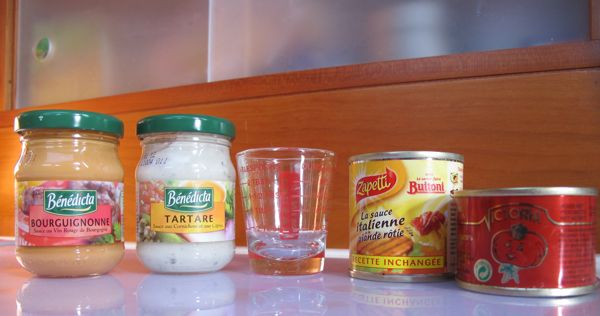
In France and the French islands of the Caribbean we discovered sauces in very small jars - handy when cooking for two.
Sometimes, we have to make substitutions or learn to live without products we enjoy at home when they are not available in the areas we are cruising. It was quite a shock to discover that peanut butter is only a staple in North America and difficult to find (or outrageously expensive) in most other countries. Now there is a big note in our provisioning binder to stock up on peanut butter when we’re going foreign!
We also take note of any changes we make in our regular routine while cruising. For example, we're real meat and potatoes people on shore but in many places around the world good meat is hard to find, expensive, or difficult to store. So when we are cruising, we are happier eating more stir-fries, stews and vegetarian meals (which are better for us anyway.)
Like many first-time cruisers, we initially made the mistake of loading the boat with canned goods we would never eat at home because books we had read said they stored well on a boat. If you don't eat canned corned beef or baked beans now, don't put them on the boat. Serving a crew food they hate will make them mutinous. On the other hand, nothing cheers up a wet miserable crew on a rainy night like a delicious meal of their favourite food or a surprise pack of a snack they love.
Building a list of food items and supplies you use regularly and annotating it with notes on how frequently you restock them, takes only a little time and starts you on the road to custom provisioning.
Go with What You Know
There are probably many things on your grocery list that you know how often to buy. For example, we know, without a doubt, that we go through 4 litres of milk every week whether living afloat or ashore. Start with the information that you know, and build from there. Any items you are uncertain about, make a point to observe and record your consumption rate in your provisioning notebook.
Of course, if you are planning a short-term cruise or cruising in an area where shopping is easy, you won’t need such in-depth records to plan your meals. But the longer and further you travel, the more helpful this kind of detailed information becomes.
When Paul and I were building our first boat, Two-Step, and our Atlantic cruise was a far-off dream, designing our stores list became an uplifting project after busy day's work. We'd quickly forget the stresses at the office as we added items to our provisioning binder and discussed the supplies we'd need for an ocean passage or a winter in the tropics.
Fuel your imagination as you create a master list of foods and supplies important to you!
Creating Your Own Provisioning Binder, Notebook or Spreadsheet
A good way to begin a custom provisions list for your cruise is to set up a binder, notebook or spreadsheet to record the supplies you use regularly. (There may even be an app for this that I haven't discovered yet. If you've found one you use, please let me know.)
Whenever you shop for food, household items or marine supplies, add the items to your book so you will have a master list of the common supplies you depend on.
The next step is to record the rate at which you consume them. This way, you will know how long things will last during your voyage and how often you will need to replace them.
A laundry marker and masking tape are useful tools to help you record the consumption rate of each item on your master list. Whenever you open a new tube of toothpaste, write that day's date on it with the laundry marker. When it's all used up, record the number of weeks it took to finish it.
Repeat the process a few times to get an average. For items that you can't or don't want to write on, such as paper towels, write the date on a piece of masking tape and stick it inside a nearby cupboard door.
Every couple of weeks, go through a cupboard in your kitchen, storage room, or the lockers in your boat to remind yourself of items that you don't buy regularly but like to have on hand. Certain spices, soup mixes, and cleaning products fit into this category for us. Add them to your lists and estimate how often you'll have to replace them if you are planning a long-term cruise.
These records are invaluable when provisioning for your cruise since they reflect your personal needs and preferences.
Check out more articles on Provisioning here.
Join our email list and get hints, technical articles and tips plus videos to help you achieve your cruising dreams.
- FREE 1/2 hour video on cruising the Exuma Islands in the Bahamas
- Technical Blog shows you how to deal with issues facing the cruising sailor
- Destination information from some of the world's best cruising areas
- Special discounts and promotions
Recipe - Seared Tuna with Coconut Rice
Thanks for the great response I got to the suggestion of posting favourite cruising recipes. I love cooking onboard and obviously you do too!
Several requests for seafood recipes came in via email and Facebook over the last couple of weeks so here's a very simple recipe I’d like to share with you for Seared Tuna that I adapted from a recipe in Jamie Oliver's 15 Minute Meals. It's an absolutely delicious meal that always “wows” dinner guests, yet is SO easy to prepare.
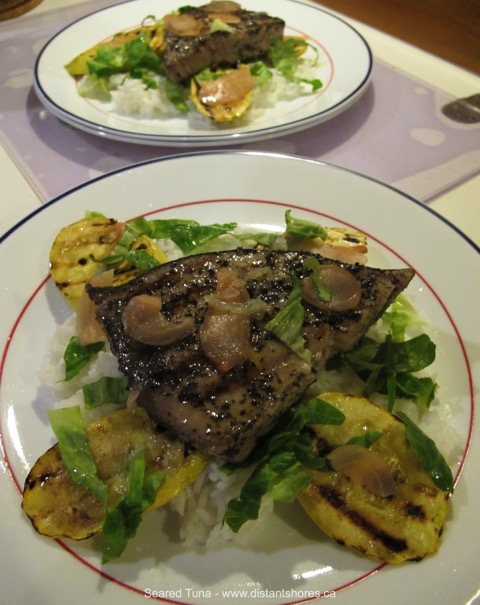
I posted this recipe on the Distant Shores Facebook Page a few months ago and people seemed to really enjoy it. By the way, if you like social media I invite you to “Like” the Distant Shores Page, ask questions and join in the discussions. It's lots of fun!
Seared Tuna with Coconut Rice
serves 4
Ingredients:
Tuna:
4 fresh tuna fillets (ask for these at your local seafood shop or lucky you if you catch your own tuna!)
2 tbsp sesame seeds (optional)
1 tsp green tea powder (simply take a tea bag of green tea, rip it open and use one teaspoon of the powder. Oregano also works well.)
Salt and pepper
½ tsp vegetable or sesame oil
Rice:
270g can of reduced fat coconut milk (I often use dried coconut milk powder which is handy on the boat.)
1 cup Basmati rice
1 cup boiling water
Pinch of salt
Garnish:
1 yellow zucchini, sliced and sautéed or grilled (I like use a grill pan)
A handful of baby spinach leaves or large leaves, chopped. (I’ve used lettuce in a pinch. Chopped green onion is nice too.)
Slivers of pickled ginger
Method:
For the rice: Place the coconut milk, rice, boiling water and salt into a medium saucepan over medium-high heat. Bring to the boil, then reduce heat to a simmer, cover and cook for about 10 minutes, until the liquid is absorbed. Remove from the heat and let sit while you prepare the rest of the meal.
For the tuna: Mix the sesame seeds, if using, with the green tea, salt and pepper on a plate, then press each tuna fillet into the mixture until all sides of the tuna are coated. Heat the oil in a frying pan or grill pan over high heat, then add the tuna and cook for 30 seconds on each side, until barely cooked on the outside and still raw on the inside. If you prefer it a little more well done like we do, cook it a little longer, about 60-90 seconds a side. It doesn’t take much. Remove from the heat. Spoon rice out onto each plate and place a fillet on top of the rice on each plate. Garnish with spinach leaves, slices of zucchini and pickled ginger slivers. Serve and enjoy!
If you like this recipe please feel free to forward it to friends...
You might also like...
Recipe - Easy Chocolate Cake
Maintaining a Home Base while Cruising
10 Tips for Cooking at Sea
Is Your Anchor Dragging?
Recipe - Easy Chocolate Cake
Cooking and entertaining onboard is one of the pleasures of the cruising life for me and a topic I enjoy speaking and writing about. So in response to your enquiries about elegant-but-easy cooking onboard I am going to begin posting some of the recipes I use while sailing aboard Distant Shores II on a regular basis.
I've decided to start with an all-time favourite – Chocolate Cake!
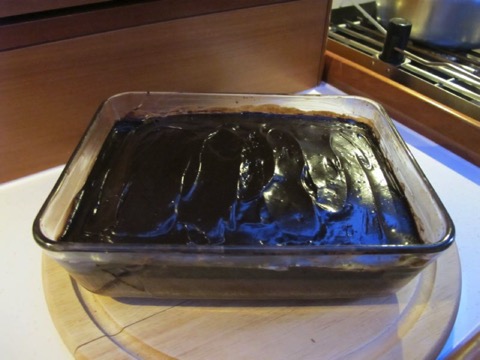
The recipe I have used for years and can mix, bake and serve in one dish is called “Po'-Boy Chocolate Cake” from Janet Groene's cookbook for sailors, campers and adventurous vacationers called “Cooking on the Go”. Janet is the author of many books for sailors including “How to Live Aboard a Boat” and has a blog called Boat Cook you might enjoy.
I have found many versions of this quick chocolate cake recipe over the years under such names as Crazy Cake and Easy Chocolate Cake when searching in other cookbooks and also online.
This recipe is great for the boat because there aren't lots of mixing bowls and utensils to clean up (saves water) and requires no eggs, just simple ingredients that are easy to keep onboard long-term. The texture is rich and firm and it's so easy to whip up even when underway!
I recently made this yummy chocolate cake as a treat and to boost our energy mid-afternoon while on passage from the British Virgin Islands to the Turks and Caicos Islands which we filmed for Distant Shores season 10 which you can download as single episodes or buy the season pass and receive new episodes as they are uploaded.
Po'-Boy Chocolate Cake
Ingredients
1 ½ cups flour
½ cup sugar
1 teaspoon baking soda
3 tablespoons unsweetened cocoa powder (not hot chocolate mix)
1 teaspoon salt
1 tablespoon white vinegar
5 tablespoons of vegetable oil
1 teaspoon of vanilla extract (I use rum)
1 cup cold water
Method
Mix the dry ingredients (the first five ingredients listed) in an eight-inch-square cake pan. I use a similar sized pyrex pan, pictured below, that has a plastic lid which makes storing the cake convenient.
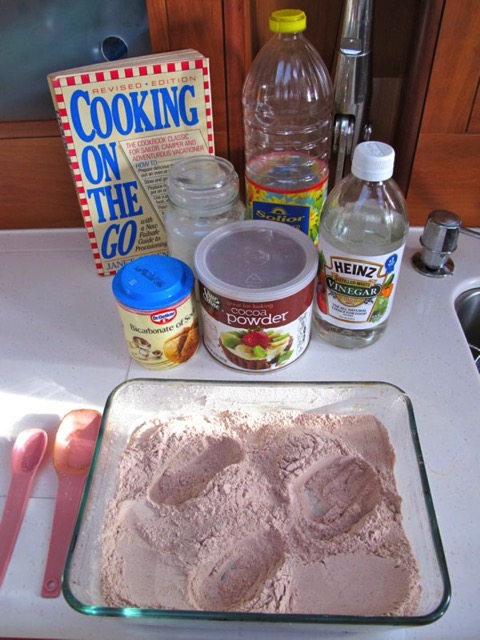
With the back of a spoon, make three holes in the mixture. Put the vanilla or rum in one, the vinegar in the second, and the oil in the third.
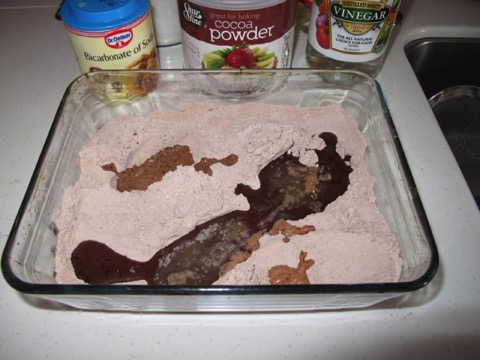
Pour the cold water over all. (It woks best if the water is really cold. I use water from a bottle I always keep chilled in the fridge. If you don't have cold water it still works but the cake is a little denser.)
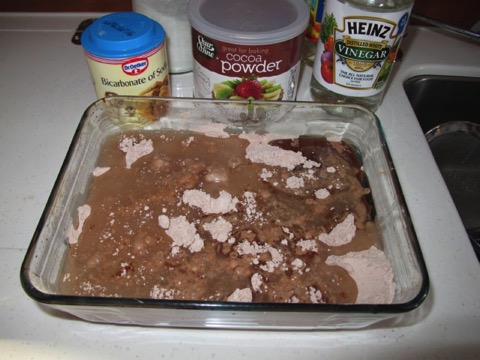
Work well with a spoon paying special attention to the corners, and make sure no unmixed dry ingredients remain.
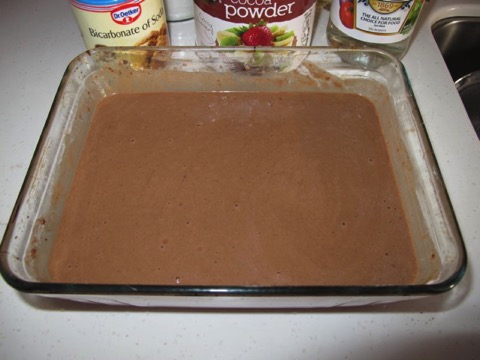
Bake in your oven at 350º F for 30-35 minutes or until springy to the touch.
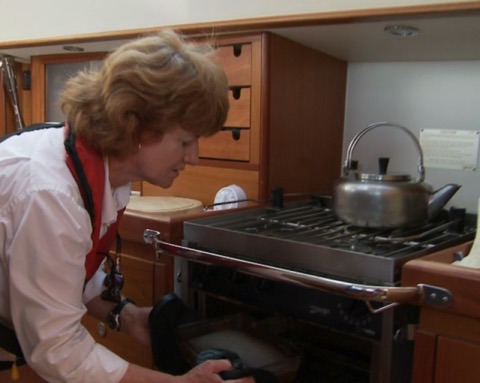
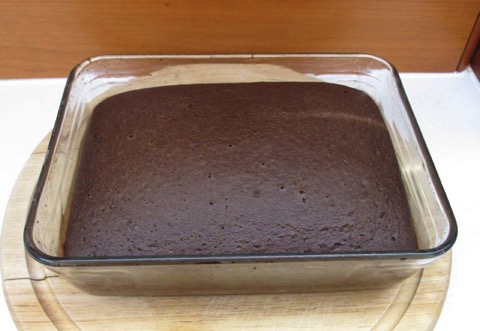
Let cool and top with your favourite homemade or store-bought chocolate icing.
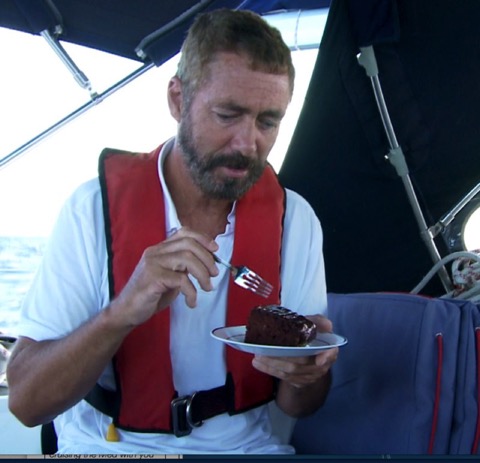
Enjoy!
Researching Destinations for your Dream Cruise?
Check out the entire Distant Shores Super Pack which now includes the newest episodes in the Caribbean, Turks & Caicos and Bahamas from Season 10.
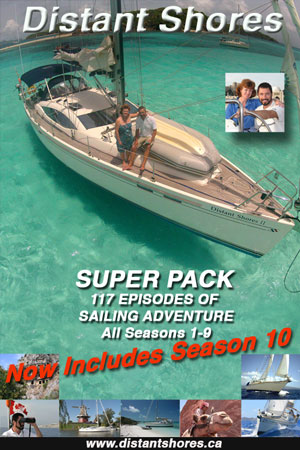
10 Tips for Cooking at Sea
By Sheryl Shard, Copyright 2015. All rights reserved.
Up until now most of my newsletters have focused on our travels with the aim of sharing our experiences to help you plan your own adventures in the many different destinations we have visited during 23 years of international cruising. But one of the most popular boat show seminars we conduct is "Outfitting and Provisioning for Cruising", so I thought for a change that I’d write about something related to this and Life On Board. Today’s topic is Cooking at Sea.
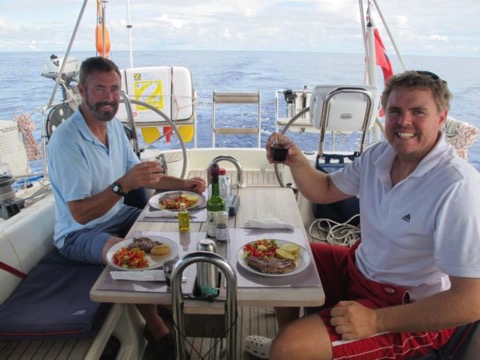
A calm day on the Atlantic with Paul and friend, Matt Heron. After days of rough weather and strenuous watch-keeping during the 2012 Atlantic Rally for Cruising (ARC) it was nice to have a sit-down meal together in the cockpit . Photo by Sheryl Shard
One of the things Paul and I love about cruising is that we have more time to prepare and enjoy delicious meals than when we’re rushing around during our busy lives ashore. We love to shop in foreign markets, experiment with new foods, and entertain friends aboard our Southerly 49 sailboat, Distant Shores II.

Cured ham at the city market in Valencia, Spain. Photo by Paul Shard.
When on passages, however, food preparation takes on a different meaning and significance. Good nutritious meals are important to maintaining our health and energy at sea, not to mention our sense of well-being when spending weeks in isolation on an ocean crossing. But the physical challenges of passage-making sometimes make meal preparation an energy-depleting exercise. In rough weather it can be downright dangerous.
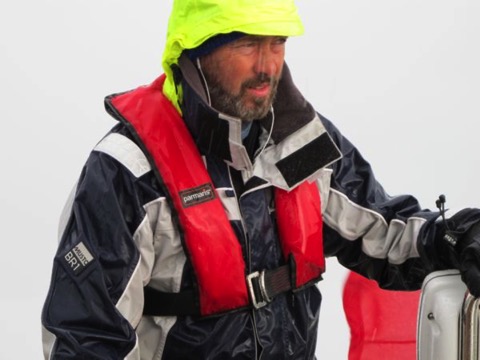
Paul at the helm after wet crossing of the North Sea from Shetland to Norway. Photo by Sheryl Shard
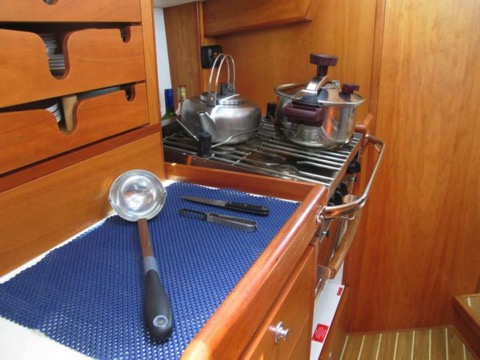
The galley on our Southerly 49 sailboat, Distant Shores II, set up for sea. Photo by Sheryl Shard.
Top 10 tips for Cooking at Sea
1. Prepare meals ahead of time: Before leaving on a passage, we try to prepare as many meals as possible before we leave the dock. It takes a few days for your body to adjust to around-the-clock watch routines so make everything easy. Like many long-distance sailors, Paul is especially susceptible to seasickness during the first 3 days of a passage so we plan light, easily digestible foods.
2. Store everything you need for meal preparation near the galley: If everything is close at hand, you will do a better job of preparing good meals since it will be less tiring than running here and there digging deep in lockers on a pitching boat. You will also be less likely to fall or injure yourself.
3. Know what you’ve got and where it is: Don’t waste your time and energy digging through lockers unnecessarily. Keep a good inventory list so you know exactly what you’ve got and where it is.
4. Top everything up before you leave the dock: Running out of dish detergent, having to change a toilet paper roll or finding the flour canister empty can bring me to tears if a storm is raging. Topping everything up before you leave the dock reduces effort and irritation.
5. Clean the boat like crazy: Odours can do you in if you’re on the verge of “mal de mar”. Make sure there are no sour sponges, dirty dish towels, gruesome laundry or icebox gremlins waiting to turn your stomach. Do your best to clean up spills so you don’t slip and fall. Check your fresh produce supply regularly so you’re not caught out by a rotting potato or mildewed melon.
6. Add safety features and use them: The safer you feel in the galley, the more pleasant your galley tasks will be. There should be lots of handholds in the galley and a galley strap at the stove so when the going gets rough the chef doesn’t land in the soup. We have pot clamps on our gimballed propane stove to keep things where they should be. We have a stainless steel safety bar in front of the stove (between the cook and “the cooker”) for added protection from burns. At sea I also cover our countertops with non-skid mats to keep bowls and utensils from flying around.
7. Keep it simple: When the weather is rough, it’s really better to stay out of the galley, if possible. Design meals to be quick and easy. We snack a lot on passages, especially in foul weather, often having several small meals rather than three major productions per day. It’s easier on the digestion and easier on the cook.
8. Come up for air: Stick your head out the companionway occasionally if you’re going to be in the galley for a while. It clears your head and makes you feel better.
9. Make clean-up easy: Design your meals so clean-up isn’t a major chore. One-pot dinners served on paper plates makes life easier for everyone when the going gets rough.
10. Make time to sit together and eat: Being only 2 people on a yacht most times while underway can make it tempting to alternate long watches and pass each other like ships in the night. Help your relationship and avoid loneliness by sitting and eating together. Even if it is only for 10 minutes, take the time to catch up and ask each other how you're feeling.

Join our email list and get hints, technical articles and tips plus videos to help you achieve your cruising dreams.
- FREE 1/2 hour video on cruising the Exuma Islands in the Bahamas
- Technical Blog shows you how to deal with issues facing the cruising sailor
- Destination information from some of the world's best cruising areas
- Special discounts and promotions
Click Here to Sign up
You Might also like the following...
Tropical Storm Chantal Arrives
Making Money While Cruising
Maintaining a Homebase
About the Southerly 49
Top 10 Canal Journeys